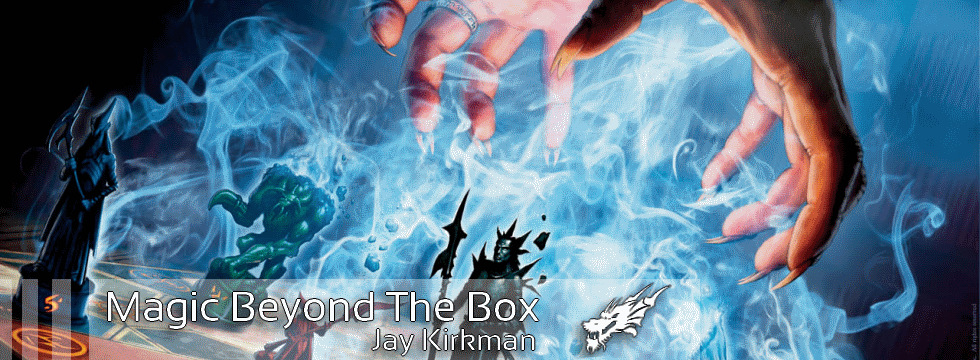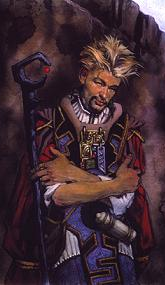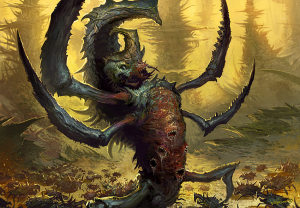Are you a Quiet Speculation member?
If not, now is a perfect time to join up! Our powerful tools, breaking-news analysis, and exclusive Discord channel will make sure you stay up to date and ahead of the curve.

 The end of a block is one of my favorite times of year with regards to Magic. Having given full reviews to each of the block's intro decks, and assigned each a rating, we can now look back over the past half a year and understand the narrative of the sets' decks. While last year's Zendikar block was a little different because of how Rise of the Eldrazi was conceptualised (a larger-size stand-alone set with new mechanics), Scars block had the opportunity to mature over the course of three releases, and we get to see how ideas, mechanics, themes, and concepts evolved over the course of the year.
The end of a block is one of my favorite times of year with regards to Magic. Having given full reviews to each of the block's intro decks, and assigned each a rating, we can now look back over the past half a year and understand the narrative of the sets' decks. While last year's Zendikar block was a little different because of how Rise of the Eldrazi was conceptualised (a larger-size stand-alone set with new mechanics), Scars block had the opportunity to mature over the course of three releases, and we get to see how ideas, mechanics, themes, and concepts evolved over the course of the year.
I also find it quite interesting to pull up the reviews for all of the Intro Deck releases, and compare how they scored against one another. We recently compiled the Five Best and Five Worst decks of Zendikar Block, and today we'll be giving the Scars offerings their fair share of attention- beginning with the best of the bunch.
This was a good year for the Intro Deck. After the rather disappointing offerings following the reduction of the Theme Deck into the Intro Pack model, the 41-card compilations from Shards of Alara through Rise of the Eldrazi were no stranger to disappointment. Seemingly assembled with the non-Magic player in mind, Scars block seems to have marked the beginnings of a shift in the deck's target focus. Although the more tightly-constructed theme decks are likely a thing of the past (particularly with the advent of the Event Decks), the decks of Scars Block have moved in that direction, looking to strike a fairer balance between the new player and the veteran.
The result? Some great precon decks, and here are the five best of them based on their graded scores at Ertai's Lament.
5. Phyrexian Poison (Scars of Mirrodin)
Mark Rosewater's epic battle to bring back poison counters is by now an oft-told tale, but it's certainly the case that Phyrexian Poison was to be our first taste of the mechanic. Of the ways you see decks develop over the course of the block is through the cards they have available to draw from. In the first set of the three, you are typically restricted to a mechanic in its simplest form- making it more intricate is the job of subsequent releases- and to be sure, Phyrexian Poison had more than its fair share of clunkers: the Blackcleave Goblin and Contagious Nim won few admirers, but the deck whispered corrupted promises and tantalising hints of power through entities like the Hand of the Praetors, Plague Stinger, and Cystbearer.
The noncreature complement was somewhat stunted, more prone to enable 'cute' plays like Carrion Call, Relic Putrescence, and Heavy Arbalest, and the deck overall was a bit sluggish, easily outpaced on the curve by decks that had a solid midgame presence. But it was a ton of fun all the same.
4. Path of Blight (Mirrodin Besieged)
By the time we were treated to Mirrodin Besieged, the Halcyon days of faint, unsuspecting cluelessness with which many Mirrans regarded the coming Phyrexian menace (see: Steady Progress) were well and truly shattered. This was war, and the Mirran's inability to see the threat for what it was gave the Phyrexians plenty of time to plant the seeds of corruption. The set was home to more than a few surprises in the colour wheel (with the hint of more to come), and what better way to represent them than with an Intro Deck? At the start infect was limited to black and green, as we saw in Phyrexian Poison, but to the surprise of many (including myself) Path of Blight dropped the black and added white.
Corrupted versions of old favourites (like Viridian Corrupter and Phyrexian Juggernaut), new and efficient creatures like Blightwidow and Rot Wolf, and above all else sights such as Priests of Norn and Choking Fumes really sealed home the flavor of Mirrodin Besieged. The Mirran-Phyrexian split would be distinctive, but it wouldn't be along color lines.
It wouldn't be an intro deck without obvious dogs like Hunters' Feast and Phyrexian Digester, but Path of Blight had plenty of upside to compensate, and was a very flavourful improvement upon the original model.
3. Ravaging Swarm (New Phyrexia)
 If I had decided to ignore six months of ratings on these decks and instead give an off-the-cuff "Top Five" list, it would likely (and unwittingly) trade a smidgen of objectivity for balance. Fortunately I have the scores to keep me honest, and they tell me that Ravaging Swarm has earned its place here as well. It may seem unbalanced in favor of infect, but if you traveled forward in time five years from now and asked players then what they remember about Scars Block, you're not likely to hear a lot about metalcraft, you'll get a few mentions of proliferate, Phyrexian mana (limited to a third set), and imprint will probably evoke nostalgia for the original Mirrodin moreseo than here. Let's face it: infect is the defining characteristic of the set, much like even now I can't think of Tempest without waxing nostalgic for buyback.
If I had decided to ignore six months of ratings on these decks and instead give an off-the-cuff "Top Five" list, it would likely (and unwittingly) trade a smidgen of objectivity for balance. Fortunately I have the scores to keep me honest, and they tell me that Ravaging Swarm has earned its place here as well. It may seem unbalanced in favor of infect, but if you traveled forward in time five years from now and asked players then what they remember about Scars Block, you're not likely to hear a lot about metalcraft, you'll get a few mentions of proliferate, Phyrexian mana (limited to a third set), and imprint will probably evoke nostalgia for the original Mirrodin moreseo than here. Let's face it: infect is the defining characteristic of the set, much like even now I can't think of Tempest without waxing nostalgic for buyback.
From the start of the block, the implications for cooperation between infect and proliferate were abundantly clear, though the tools for both (particularly the latter) were quite limited. With the full maturation of the block in New Phyrexia, we were at last treated to a deck which fulfilled that early promise, one which broke with convention by including not one but two new mechanics. Once again retaining green, it picks up blue as its secondary color, a pairing perfectly represented in the combo-in-a-box Viral Drake. Despite picks like Wall of Tanglecord and the tragic Defensive Stance, the deck has a well-planned strategy including the finally-printed infected one-drop (Glistener Elf) and Spinebiter to get those critical first few poison counters on no matter the stage in the game, so that proliferate can complete its grim task.
2. Life for Death (New Phyrexia)
Like cascade, Phyrexian mana will be remembered for its very pronounced elbow to the ribs of the game's central mechanics. Yet it is for the most part safely contained in scope due to the limitation of its release: a single set. Cascade tweaked the notion of card advantage: pay a little bit more for a creature or spell now and, if luck holds, you can end up getting a lot back in the bargain. Phyrexian mana, on the other hand, goes straight to the heart of the color wheel and brazenly tweaks it. By substituting life for colored mana most any deck now has access to [card Gut Shot]burn[/card], [card Mutagenic Growth]growth[/card], [card Mental Misstep]countermagic[/card], [card Apostle's Blessing]protection[/card], and [card Dismember]kill[/card], all things generally limited to one slice of the pie.
From this roiling brew steps the Boros-colored Life for Death, which not only packs in a generous serving of Phyrexian mana cards, but does so with flair. For one, it makes lifegain actually feel relevant with cards like Whitesun's Passage and Pristine Talisman. It gives you some very solid beats with a trio of [card Porcelain Legionnaire]Porcelain Legionnaires[/card] and Moltensteel Dragon. And on top of it all, it lets you live the combo dream with a pair of Rage Extractors. There's a high novelty factor to playing with your life as a resource, and unlike Suicide Black strategies, the optional nature of Pyrexian mana makes the perfect introduction to newer players to the concept of regarding your life total as just another resource. An all-around fantastic deck.
But of course, only one deck can come in first, and that leaves us with...
1. Mirromancy (Mirrodin Besieged)
Based on the chatter that surrounded this deck, it's likely to lay claim to the distinction of 'most controversial' with little difficulty, but suspend judgment for a moment and permit me to lay the case for this deck not only earning the number one position in this article, but being one of the most radical Intro Decks in the brief history of the format.
With Shards of Alara, the Theme Deck as we knew it was dead. Since Tempest we'd been treated to a handful of theme decks every release, 60 cards somewhat tightly wrapped around a concept or theme associated with the set. In a sense, there was a certain kinship with Constructed play here, as consistency was a feature that the designers of these decks took into consideration. Another was novelty; these decks took risks if it meant highlighting their purpose. The most famous example is The Sparkler from Stronghold, whose deck included only three creatures: Mogg Fanatic, Wall of Tears, and Wall of Razors. The deck paired up countermagic and burn with a buyback twist, letting you burn out your opponent over and over until dead.
Mercadian Masques's Disruptor went after your manabase and your hand, leaving you crippled as its creatures finished you off. Planeshift's Comeback was creature-heavy, sure, but its gating mechanic and colour-based gameplay gave it a very distinctive (and even combo-ish) feel. Tribal decks like Elvish Rage from Legions baked a thick layer of flavour on its beaters, while Mirrodin's Sacrificial Bam made an art form out of casting artifacts, and then grinding them up yourself. Guildpact's Izzet Gizmometry made its hay through repeatable noncreature spells and the replicate mechanic, having very few real beaters of its own. Beyond the Grave from Coldsnap did for creature recursion what Bam did for artifacts. Future Sight's Suspended Sentence has all the intricate feel of crawling into a grandfather clock, watching precise gears unite for common purpose. These were decks that had a solid sense of identity to go along with both the fun of playing them, and their place as a showcase for the set's mechanics and themes. To be certain there were more conventional options even then, but their consistent development was a great sign of the health of the format.
With the advent of the 41-card Intro Deck, however, this sort of biodiversity took a back seat to a rather bland formula which emphasised the simplest aspects of the game and aimed squarely at newer players at the expense of those already established within in.
Step One: Take a bunch of creatures
Step Two: Mix in a smattering of noncreature support and removal, emphasizing variety over consistency, along with some deliberate lemons (to encourage nascent deckbuilders to tinker)
Step Three: Package for sale
When the Intro Decks for Scars of Mirrodin were released, I sensed even then a return to the more classic form of the theme deck. When Mirrodin Besieged followed suit, I felt that we were on the verge of a renaissance. If there was one deck that convinced me of this moreso than any other, it was Mirromancy. Boasting nineteen instants and sorceries (versus only seventeen creatures), the deck seemed built to optimise its foil premium rare, Galvanoth. Further, it was a very radical break with the modern formula, and while being a bit streaky is a sheer joy to play.
I don't regard Alara or Zendikar Blocks' decks as failures, nor do I believe that they represent a failed model. Rather, I acknowledge that the repositioning of the theme deck into the intro deck isn't such a bad idea, and that Wizards has been tinkering with the model ever since. That we can get to a point where a deck like Mirromancy has been published tells us that Spring has arrived to the precon format after a two-year Winter.
As always, your results may vary! I'd be delighted to hear other opinions on what decks should have made the list, or which one you felt should have topped number one!
_____________________________
Jay Kirkman






Great list, although I really expected Artful Destruction to be in it. That deck can be overwhelming against other intro packs, can stand on its own in a casual constructed environment and has a flavorful theme.
By the way, I’m loving Life for Death. Playing it is so much fun it’s not even funny.
i don't agree with mirromancy, but the others are all pretty good to me.
However, i think Artful Destruction and Myr of Mirrodin could also be in the list, they're solid and tribal decks are usually interesting.
The note provided that all principal and accrued
interest was due in a single balloon payment at the end of the note term,
and neither principal nor interest could be prepaid.
If you have received IRS tax notice, you need
not to be panic. I decided to use their OIC service
to lower my tax bill.
Feel free to surf to my website; boca raton financial advisor jobs